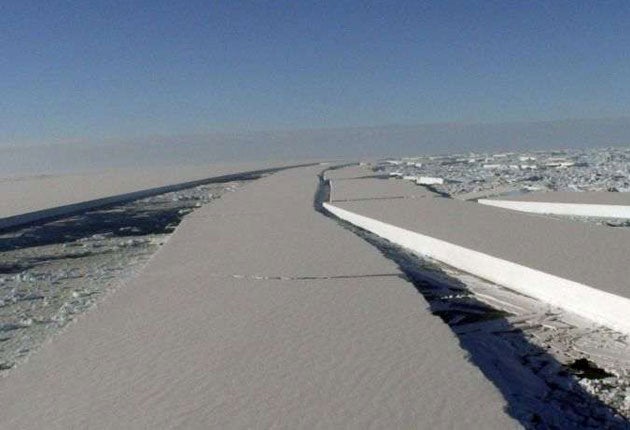Climate warning as Antarctic ice bridge shatters

Your support helps us to tell the story
From reproductive rights to climate change to Big Tech, The Independent is on the ground when the story is developing. Whether it's investigating the financials of Elon Musk's pro-Trump PAC or producing our latest documentary, 'The A Word', which shines a light on the American women fighting for reproductive rights, we know how important it is to parse out the facts from the messaging.
At such a critical moment in US history, we need reporters on the ground. Your donation allows us to keep sending journalists to speak to both sides of the story.
The Independent is trusted by Americans across the entire political spectrum. And unlike many other quality news outlets, we choose not to lock Americans out of our reporting and analysis with paywalls. We believe quality journalism should be available to everyone, paid for by those who can afford it.
Your support makes all the difference.An ice bridge which held a vast Antarctic ice shelf in place shattered at the weekend and could herald a wider collapse linked to global warming, a leading scientist has warned.
"It's amazing how the ice has ruptured. Two days ago it was intact," said David Vaughan, a glaciologist with the British Antarctic Survey.
A satellite picture from the European Space Agency showed that a 25 mile-long strip of ice believed to pin the Wilkins Ice Shelf in place had splintered at its narrowest point, about 500 metres wide.
The Wilkins, now the size of Jamaica, is one of 10 shelves to have shrunk or collapsed in recent years on the Antarctic Peninsula, where temperatures have risen in recent decades apparently because of global warming.
The satellite image showed a jumble of huge flat-topped icebergs in the sea where the ice bridge had been on Friday. Mr Vaughan, who landed on the flat-topped ice bridge in January in a ski-equipped plane said change in Antarctica was rarely so dramatic. It was his first – and last – visit to the area.
In January, the remaining ice bridge had been surrounded by icebergs the size of shopping malls, many of them trapped in sea ice. A few seals were visible lolling on sea ice in the low Antarctic sunshine.
The loss of the ice bridge, jutting about 20 metres out of the water and almost 100km (62 miles) wide in 1950, may now allow ocean currents to wash away far more of the Wilkins shelf. "My feeling is that we will lose more of the ice, but there will be a remnant to the south," said Mr Vaughan. Ice shelves float on the water, and can be hundreds of metres thick.
Nine other shelves have receded or collapsed around the Antarctic Peninsula in the past 50 years, often abruptly like the Larsen A in 1995 or the Larsen B, further north, in 2002. Cores of sediment on the seabed indicate some of these ice shelves had been in place for at least 10,000 years.
Temperatures on the Antarctic Peninsula have risen by up to about 3C in the past 50 years, the fastest rate of warming in the southern hemisphere. "We believe the warming on the Antarctic Peninsla is related to global climate change, though the links are not entirely clear," Mr Vaughan said. Antarctica's response to warming will go a long way to deciding the pace of global sea level rise.
About 175 nations have been meeting in Bonn, Germany, since 29 March 29 as part of a push to negotiate a new treaty ahead of the United Nations Climate Change Conference in Copenhagen, from 7 to 18 December of 2009. The current talks end on Wednesday.
The loss of ice shelves does not affect sea levels – floating ice contracts as it melts and so does not raise ocean levels. But their loss can allow glaciers on land to slide more rapidly towards the sea, adding water to the oceans.
Join our commenting forum
Join thought-provoking conversations, follow other Independent readers and see their replies
Comments